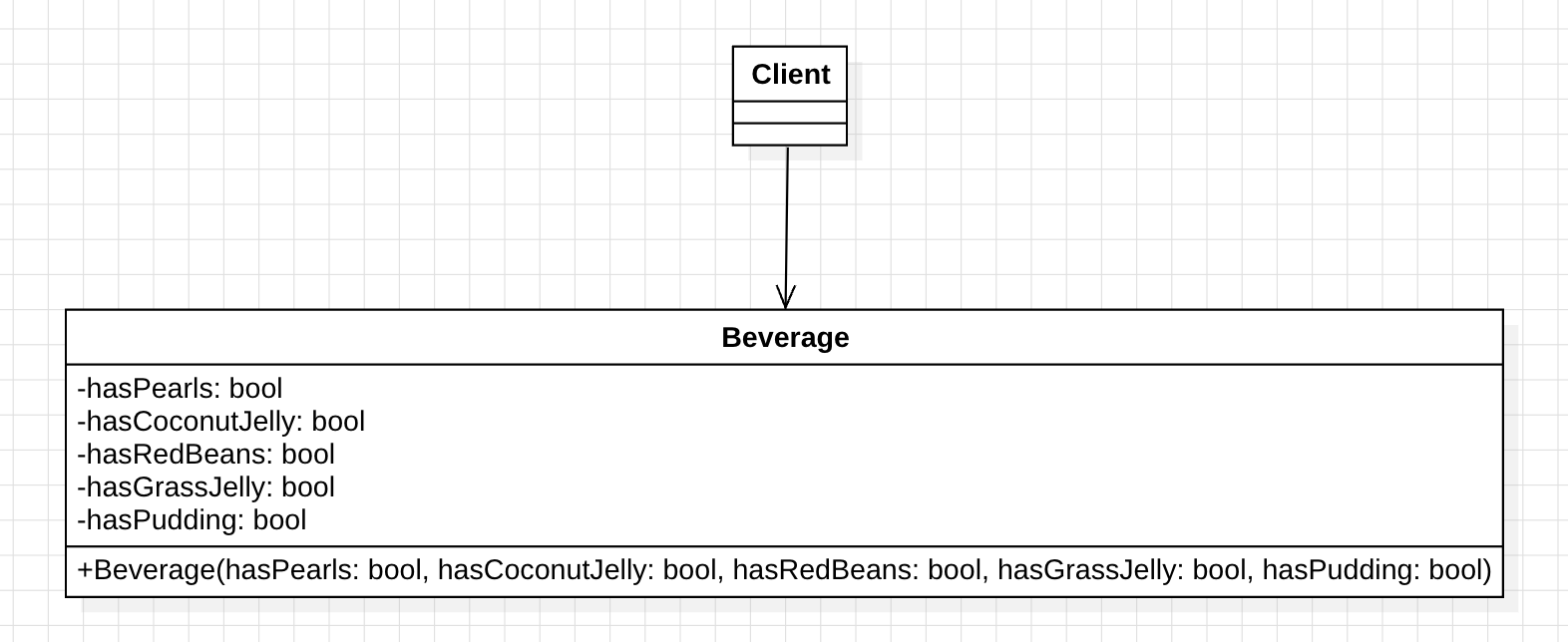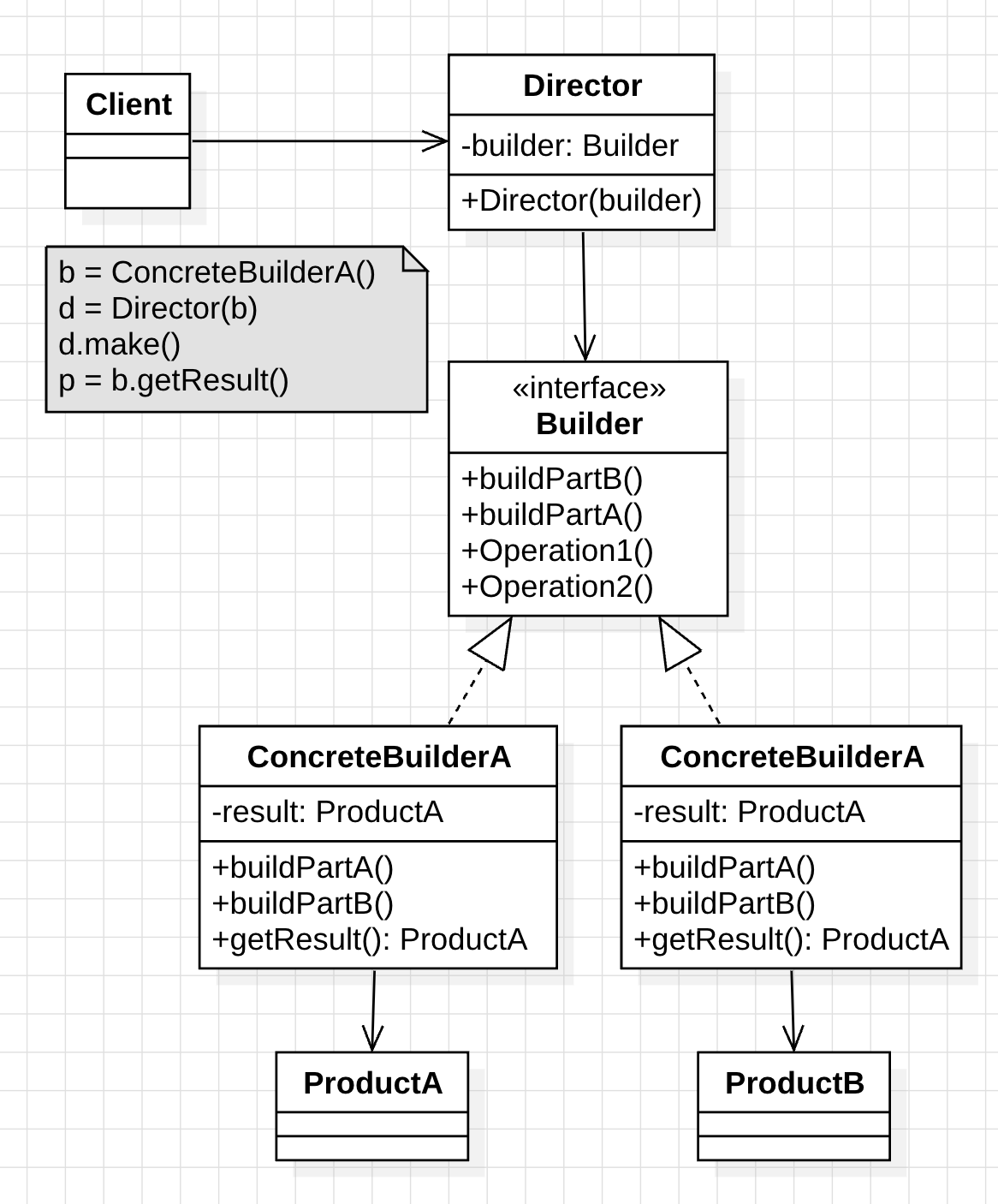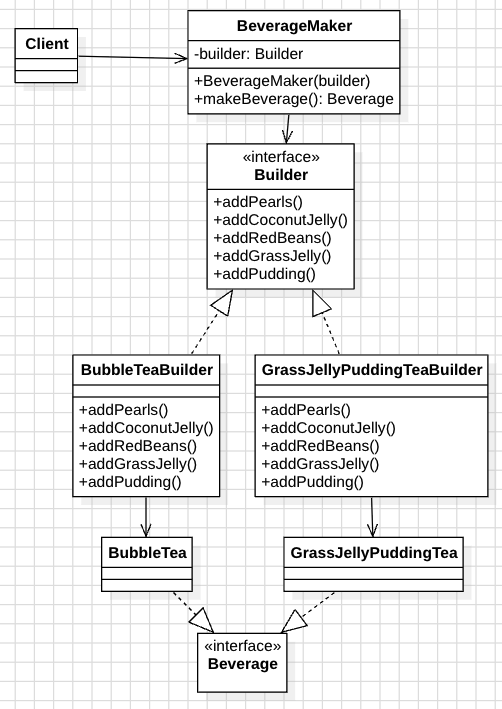Design Pattern (8) Builder Pattern Complete Tutorial - Step-by-Step Construction of Complex Objects
You can download the Design Pattern series code from this design_pattern repo.
Introduction: From Factory to Customization
In the previous two articles, we explored the Factory Method Pattern and Abstract Factory Pattern, both of which focus on the problem of “what products to create.” Today, we will face a new challenge: “how to create complex products.”
Requirements: The Customization Challenge of Bubble Tea
Business Upgrade Requirements
Today we want to design an intelligent machine that can automatically make bubble tea. After market research, we found that if a bubble tea shop only sells basic black tea and green tea, it definitely cannot satisfy the diverse needs of modern consumers.
Modern customers pursue personalized experiences, and they hope to be able to:
- Freely choose toppings: Add different toppings based on personal preferences
- Flexible combinations: The same drink can contain multiple types of toppings
- Personalized taste: Create their own unique flavors
Available Toppings List
We’ve decided to provide the following rich topping options to attract customers:
- Pearls: Classic chewy texture
- Coconut Jelly: Refreshing coconut flavor
- Red Beans: Traditional sweet taste
- Grass Jelly: Cool and refreshing taste
- Pudding: Rich creamy enjoyment
Object-Oriented Analysis (OOA)
Initial Design Attempt
After understanding the requirements, let’s conduct object-oriented analysis. The intuitive approach is to add all possible topping properties to the beverage class:

Problems with the First Approach
This design brings serious problems: if we only want to add red beans and pudding today, we must pass false or null for other unused parameters.
Problem Points:
- Lengthy Parameters: As toppings increase, the parameter list becomes very long
- Poor Readability: Difficult to understand the meaning of each parameter
- Maintenance Difficulties: All calling locations need modification when adding toppings
- High Error Rate: Easy to pass wrong parameters or miss parameters
Second Approach: Multiple Constructors
You might think of using multiple different constructors to solve this, so you don’t need to pass unused parameters:

Recognizing Problems (Forces)
The Dilemma of Multiple Constructor Approach
After deep analysis of the second approach, we discovered more serious problems:
Combinatorial Explosion: As the number of toppings increases, the number of required constructors grows exponentially. With 5 types of toppings, we theoretically need 2^5 = 32 different constructors to cover all combinations!
Maintenance Nightmare:
- Every time we add toppings, we need to significantly modify existing code
- Constructors can easily be confused, increasing the risk of usage errors
- The class becomes extremely large and difficult to understand
Telescoping Constructor Anti-pattern
This phenomenon is called the Telescoping Constructor anti-pattern:
Definition: When a class has multiple constructors with different numbers of parameters, leading to code that’s difficult to maintain and use.
Typical Characteristics:
- Number of constructors grows exponentially with parameter combinations
- High code duplication
- Users easily choose wrong constructors
- Extremely high maintenance costs when adding parameters
We need a more elegant solution to handle this complex object construction requirement.
Applying Builder Pattern (Solution)
Pattern Introduction
After completing object-oriented analysis (OOA), recognizing problem points (Forces), and understanding the entire problem context (Context), we can apply the Builder Pattern to solve this complex object construction problem.
Let’s first understand the standard structure of the Builder Pattern:

Core Roles of Builder Pattern
The Builder Pattern mainly includes the following five key roles:
1. Product
The final result of complex objects. It may contain multiple components or parts, whose structure varies according to different builder implementations. Product is usually a class whose attributes represent different parts constructed by the Builder.
2. Builder (Abstract Builder)
Defines the abstract interface for constructing complex objects. It declares methods for constructing various parts of the product, allowing creation of different concrete builders to produce different variants of the product.
3. ConcreteBuilder (Concrete Builder)
Implements the Builder interface, providing concrete implementations for constructing each part of the product. Each ConcreteBuilder is tailored for specific product variants and is responsible for tracking the state of the product being constructed.
4. Director
Responsible for managing the construction process of complex objects. It works with the Builder to provide high-level construction process control, but doesn’t need to know the specific construction details of each part of the object.
5. Client
The code that initiates the complex object construction process. It creates Builder objects and passes them to the Director, retrieving the final product from the Builder after construction is complete.
Applying to Bubble Tea System
Let’s apply the Builder Pattern to the bubble tea making system:

Through this design, we get a completely new and elegant solution (Resulting Context) that can flexibly handle complex bubble tea construction requirements.
Object-Oriented Programming (OOP)
Implementing Builder Pattern
Now let’s convert the Builder Pattern design into code implementation. Through step-by-step construction processes, we can elegantly handle the creation of complex beverages.
Product Interface Definition
First, define the abstract interface for beverages:
interface Beverage {
var hasPearls: Boolean
var hasCoconutJelly: Boolean
var hasRedBeans: Boolean
var hasGrassJelly: Boolean
var hasPudding: Boolean
}
Concrete Product Classes
Next, implement concrete beverage products:
Bubble Tea:
data class BubbleTea(override var hasPearls: Boolean,
override var hasCoconutJelly: Boolean = false,
override var hasRedBeans: Boolean = false,
override var hasGrassJelly: Boolean = false,
override var hasPudding: Boolean = false
): Beverage {
}
Grass Jelly Pudding Tea:
data class GrassJellyPuddingTea(override var hasPearls: Boolean = false,
override var hasCoconutJelly: Boolean = false,
override var hasRedBeans: Boolean = false,
override var hasGrassJelly: Boolean,
override var hasPudding: Boolean
): Beverage {
}
Abstract Builder Interface
Define the common interface for builders:
interface Builder {
fun addPearls(): Builder
fun addPudding(): Builder
fun addGrassJelly(): Builder
fun build(): Beverage
}
Concrete Builder Implementations
Bubble Tea Builder:
class BubbleTeaBuilder: Builder {
private var bubbleTea = BubbleTea(false)
override fun addPearls(): BubbleTeaBuilder {
bubbleTea.hasPearls = true
return this
}
override fun addPudding(): Builder {
return this // Bubble tea doesn't support pudding, return directly
}
override fun addGrassJelly(): Builder {
return this // Bubble tea doesn't support grass jelly, return directly
}
override fun build(): BubbleTea {
return bubbleTea
}
}
Grass Jelly Pudding Tea Builder:
class GrassJellyPuddingTeaBuilder: Builder {
private var grassJellyPuddingTea = GrassJellyPuddingTea(
false,
hasCoconutJelly = false,
hasRedBeans = false,
hasGrassJelly = false,
hasPudding = false
)
override fun addPearls(): Builder {
return this // Grass jelly pudding tea doesn't support pearls, return directly
}
override fun addGrassJelly(): GrassJellyPuddingTeaBuilder {
grassJellyPuddingTea.hasGrassJelly = true
return this
}
override fun addPudding(): GrassJellyPuddingTeaBuilder {
grassJellyPuddingTea.hasPudding = true
return this
}
override fun build(): GrassJellyPuddingTea {
return grassJellyPuddingTea
}
}
Director Class
Responsible for controlling the high-level logic of the construction process:
class BeverageMaker(val builder: Builder) {
fun makeBubbleTea(): Beverage {
return builder.addPearls().build()
}
fun makeGrassJellyPuddingTea(): Beverage {
return builder.addGrassJelly().addPudding().build()
}
}
Client Usage Example
Finally, the actual usage code:
fun main() {
// Make bubble tea
val bubbleTeaBuilder = BubbleTeaBuilder()
val bubbleTeaBeverageMaker = BeverageMaker(bubbleTeaBuilder)
val bubbleTea = bubbleTeaBeverageMaker.makeBubbleTea()
println(bubbleTea)
// Make grass jelly pudding tea
val grassJellyPuddingTeaBuilder = GrassJellyPuddingTeaBuilder()
val grassJellyPuddingTeaBeverageMaker = BeverageMaker(grassJellyPuddingTeaBuilder)
val grassJellyPuddingTea = grassJellyPuddingTeaBeverageMaker.makeGrassJellyPuddingTea()
println(grassJellyPuddingTea)
}
Pattern Advantages Demonstrated
Through the Builder Pattern, we successfully solved the problem of complex object construction:
Fluent Construction Process: Able to clearly make bubble tea step by step, with each step’s intention very clear.
Avoiding Telescoping Constructor: No longer need huge parameter lists or numerous constructors.
Flexibility: Can easily support new beverage types and topping combinations.
Readability: Code intention is clear, easy to understand and maintain.
Builder Pattern Application Scenarios
Applicable Timing Judgment
The Builder Pattern is particularly useful in the following situations:
Complex Object Construction: When objects contain multiple optional properties, and these property combinations are very complex.
Step-by-Step Construction Requirements: When object construction processes require multiple steps, and these steps have specific orders or logic.
Avoiding Telescoping Constructor: When constructor parameters are too many, leading to code that’s difficult to maintain and understand.
Different Representation Requirements: When the same construction process needs to create objects with different representations.
Real-World Examples
SQL Query Builder:
val query = QueryBuilder()
.select("name", "email")
.from("users")
.where("age > 18")
.orderBy("name")
.build()
HTTP Request Builder:
val request = HttpRequestBuilder()
.url("https://api.example.com/users")
.method(GET)
.header("Authorization", "Bearer token")
.timeout(30000)
.build()
Evolution of Creational Patterns
Progression from Simple to Complex
Through this series of learning, we’ve seen the evolution of creational patterns:
- Simple Factory Pattern: Solves basic object creation problems
- Factory Method Pattern: Increases extensibility, supports different product types
- Abstract Factory Pattern: Handles product family creation, supports two-dimensional relationships
- Builder Pattern: Focuses on step-by-step construction processes of complex objects
Each pattern targets specific problem scenarios, and choosing the appropriate pattern is an important skill in software design.
Summary
Pattern Value
The Builder Pattern provides us with an elegant way to handle complex object construction problems. It separates construction logic from representation, making code clearer and more flexible.
Key Benefits
- Solves Telescoping Constructor: Avoids problems with overly long parameter lists
- Improves Readability: Construction process is clear and easy to understand
- Enhances Flexibility: Easy to support new product variants
- Separates Concerns: Construction logic is separated from product representation
Design Principles Embodied
The Builder Pattern embodies multiple important design principles:
- Single Responsibility Principle: Each builder is only responsible for specific type of product construction
- Open Closed Principle: Open to extension, easy to add new builders
- Program to Interfaces: Depend on abstract builder interfaces rather than concrete implementations
- Encapsulate What Varies: Encapsulate changing construction logic in different builders
Relationship with Other Creational Patterns
- vs Abstract Factory: Builder focuses on “how to construct,” Abstract Factory focuses on “what to construct”
- vs Factory Method: Builder supports step-by-step construction, Factory Method typically creates at once
- Complementarity: Can be used together, for example using Factory Method to create builder instances
Future Outlook
Learning design patterns is an important part of improving software design capabilities. Mastering these patterns can not only solve specific technical problems but also cultivate good design thinking, laying a solid foundation for developing complex software systems.
Note: If you have any suggestions, questions, or different ideas, feel free to leave a comment or send me an email. We can discuss and learn together
Enjoy Reading This Article?
Here are some more articles you might like to read next: